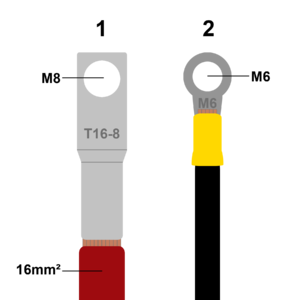Wire terminal
Terminals are used to make safe and lasting mechanical connections in electrical systems. Terminals that are mechanically crimped (compressed) with a tool are the standard for off-grid PV installations. A terminal must be properly chosen based upon:[1]
- The size wire that will be inserted into it. Terminals will often be marked for the size wire that they will except like in the diagram.
- The size bolt that will be used to anchor it. Terminals should be marked for the size hole that they have.
- The stranding of the wire that it will be used with. Fine stranded battery cable may require larger than standard size terminals.
When crimping the terminal, the proper size and type of crimping tool must be used to ensure a good connection. If an improper tool is used - like a hammer or another type of pliers - it is likely that the connection will come lose and fail over time.
Insulated terminals
Insualted terminals for smaller wire gauges have been standardized using a simple color scheme that works for both AWG and mm² wire sizes.[2]
| Color | Standard metric size (mm²) | Standard AWG size |
|---|---|---|
| Red | .5-1 mm² | 22-16 AWG |
| Blue | 1.5-2.5 mm² | 16-14 AWG |
| Yellow | 4-6 mm² | 12-10 AWG |
Terminals for flooded lead acid batteries
The gasses released by flooded lead acid batteries can cause corrosion can occur on terminals over time, which will create a high resistance connection that can represent a safety hazard. There are several recommended practices to avoid corrosion and any resulting issues:
- Terminals should not be bare copper. They should be tinned (silver in color) as the tin does not corrode like copper.
- Terminals should be coated in anti-corrosive grease.
- Terminals should not leave any copper from the wires exposed. Terminals for use with lead acid batteries should have a closed-end rather than an open end that allows one to see the wire that has been inserted. Additionally, where the wire enters the back of the terminal should be coated in heat shrink or electrical tape to prevent the entrance of gasses produced from the batteries.
Notes/references
- ↑ Thomas & Betts Compression Terminal Catalogue http://www.tnb.com/pubint/docs/colorkeyed_spec.pdf
- ↑ PANDUIT terminal size chart http://www.innovative.com.mx/wp-content/uploads/2015/10/Metric-Ring-Terminal-Vinyl-Insulated-Funnel-Entry.png
